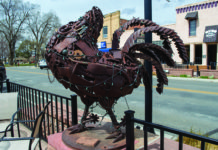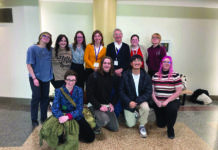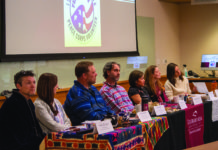“In the meantime, let your imagination take you to erotic frontiers,” Dr. John Nizalowski said. Several of the audience members chuckle, the absurdity of the situation taking hold. A professor, suggesting that they think such impure thoughts?
Yet, Professor Nizalowski is serious. He and Professor Luis Silva-Villar are presenting at the Poets and Writers of Colorado Mesa University, a program founded eleven years ago by Nizalowski that invites faculty and community to read or perform their written work to a passionate audience. Silva-Villar and Nizalowski are in a poetry duo called N&S.

“What we do is in the Dadaist poetic tradition – a mixture of poetry, theater, and absurdist comedy,” Nizalowski said. “Dr. Jennifer Hancock, a published poet and a professor at CMU, calls us ‘the vaudeville of poetry.’”
Absurdist indeed. Aside from his sordid invitation to interpret old Greek poetry as less than wholesome, N&S lead their performance of “Great Poems About Beep,” to raucous applause. Think of it like Mad Libs for old poetry. In particular, tonight they focus on Constantine Cavafy, translated from Greek and in their words, “ruined from English by N&S.”
As Nizalowski reads from the dusty poem, Silva-Villar jumps in every few words to say the word, “beep,” and later various animal sounds, as a censor, to invite the audience to think about what sorts of horrible words they could be covering up.

It’s an exercise in comedy and imagination, and to great success, as the audience giggles at some of the goofier phrases. Silva-Villar varies the sound of his beeps, some of them high pitched, other at a low growl, to make the rest of us wonder what some of the beeps mean.
Professor Robin Calland is also presenting some of her work. An excerpt from a passage of a new novel she’s writing. “I can’t tell you a lot about it, because, yeah. It just kind of flows out of me,” Calland said. She doesn’t know herself about where exactly the story is leading her. So far, there’s a twin sister, a cat named Snowdrift and a dragon. Calland just goes along with it, knowing that the ideas will come to her as she writes.
“By exploring our surroundings, we incorporate our experiences in pure text,” Silva-Villar said about the inspiration for the poems. Silva-Villar seems to find a particular fascination with birthstones and their respective months, and and their symbolism. He begin to read. “That gem. Do you wear it to escape the terrors of the night? Or do wear it to escape my cooking tonight?”
Nizalowski says that his experiences teaching at the Penitentiary of New Mexico don’t have as much of a presence in his writing as he would expect, but he still speaks vividly of his experiences with the inmates there. “The environment was both unnerving and fascinating, especially after the night classes. When the razor wire fences glinted under the perimeter lights, and the stray cats would peer with ghost-faces through the barred windows, begging for food,” Nizalowski said.
Calland draws upon her past experience

s as well for her writing, such as making her twin sister a key figure in her new novel idea.
Drawing on past experiences and present connections, whether it be through an absurdist skit, the germination of a new idea for a book, or poems about gemstones, Poets and Writers of CMU offers a peek into the imagination of writers and creators at heart.






